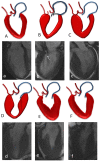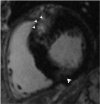The diagnosis of hypertrophic cardiomyopathy by cardiovascular magnetic resonance
- PMID: 22348519
- PMCID: PMC3309929
- DOI: 10.1186/1532-429X-14-17
The diagnosis of hypertrophic cardiomyopathy by cardiovascular magnetic resonance
Abstract
Hypertrophic cardiomyopathy (HCM) is the most common genetic disease of the heart. HCM is characterized by a wide range of clinical expression, ranging from asymptomatic mutation carriers to sudden cardiac death as the first manifestation of the disease. Over 1000 mutations have been identified, classically in genes encoding sarcomeric proteins. Noninvasive imaging is central to the diagnosis of HCM and cardiovascular magnetic resonance (CMR) is increasingly used to characterize morphologic, functional and tissue abnormalities associated with HCM. The purpose of this review is to provide an overview of the clinical, pathological and imaging features relevant to understanding the diagnosis of HCM. The early and overt phenotypic expression of disease that may be identified by CMR is reviewed. Diastolic dysfunction may be an early marker of the disease, present in mutation carriers prior to the development of left ventricular hypertrophy (LVH). Late gadolinium enhancement by CMR is present in approximately 60% of HCM patients with LVH and may provide novel information regarding risk stratification in HCM. It is likely that integrating genetic advances with enhanced phenotypic characterization of HCM with novel CMR techniques will importantly improve our understanding of this complex disease.
Figures



Similar articles
-
Clinical utility of cardiovascular magnetic resonance in hypertrophic cardiomyopathy.J Cardiovasc Magn Reson. 2012 Feb 1;14(1):13. doi: 10.1186/1532-429X-14-13. J Cardiovasc Magn Reson. 2012. PMID: 22296938 Free PMC article. Review.
-
T1 measurements identify extracellular volume expansion in hypertrophic cardiomyopathy sarcomere mutation carriers with and without left ventricular hypertrophy.Circ Cardiovasc Imaging. 2013 May 1;6(3):415-22. doi: 10.1161/CIRCIMAGING.112.000333. Epub 2013 Apr 2. Circ Cardiovasc Imaging. 2013. PMID: 23549607 Free PMC article.
-
The development of familial hypertrophic cardiomyopathy: from mutation to bedside.Eur J Clin Invest. 2011 May;41(5):568-78. doi: 10.1111/j.1365-2362.2010.02439.x. Epub 2010 Dec 15. Eur J Clin Invest. 2011. PMID: 21158848 Review.
-
The current and emerging role of cardiovascular magnetic resonance imaging in hypertrophic cardiomyopathy.J Cardiovasc Transl Res. 2009 Dec;2(4):415-25. doi: 10.1007/s12265-009-9136-3. Epub 2009 Nov 7. J Cardiovasc Transl Res. 2009. PMID: 20560000 Review.
-
CMR with late gadolinium enhancement in genotype positive-phenotype negative hypertrophic cardiomyopathy.JACC Cardiovasc Imaging. 2012 Jan;5(1):119-22. doi: 10.1016/j.jcmg.2011.08.020. JACC Cardiovasc Imaging. 2012. PMID: 22239901 No abstract available.
Cited by
-
Free-Breathing Motion-Corrected Single-Shot Phase-Sensitive Inversion Recovery Late-Gadolinium-Enhancement Imaging: A Prospective Study of Image Quality in Patients with Hypertrophic Cardiomyopathy.Korean J Radiol. 2021 Jul;22(7):1044-1053. doi: 10.3348/kjr.2020.1296. Epub 2021 Apr 1. Korean J Radiol. 2021. PMID: 33856138 Free PMC article.
-
Severe Midventricular Hypertrophic Obstructive Cardiomyopathy and Apical Aneurysm.J Cardiovasc Echogr. 2013 Jul-Sep;23(3):81-83. doi: 10.4103/2211-4122.123954. J Cardiovasc Echogr. 2013. PMID: 28465890 Free PMC article.
-
The Role of Cardiac MRI in the Diagnosis and Risk Stratification of Hypertrophic Cardiomyopathy.Arrhythm Electrophysiol Rev. 2016;5(3):197-202. doi: 10.15420/aer.2016:13:3. Arrhythm Electrophysiol Rev. 2016. PMID: 28116085 Free PMC article.
-
Two Birds With One Stone: The Decisive Role of Cardiac MRI in Identifying Both Hypertrophic Cardiomyopathy and Pericarditis Simultaneously in a Patient with Chest Pain.Cureus. 2020 Oct 7;12(10):e10843. doi: 10.7759/cureus.10843. Cureus. 2020. PMID: 33173649 Free PMC article.
-
Novel Morphological Features on CMR for the Prediction of Pathogenic Sarcomere Gene Variants in Subjects Without Hypertrophic Cardiomyopathy.Front Cardiovasc Med. 2021 Sep 17;8:727405. doi: 10.3389/fcvm.2021.727405. eCollection 2021. Front Cardiovasc Med. 2021. PMID: 34604355 Free PMC article.
References
-
- Charron P, Carrier L, Dubourg O, Tesson F, Desnos M, Richard P, Bonne G, Guicheney P, Hainque B, Bouhour JB. et al.Penetrance of familial hypertrophic cardiomyopathy. Genet Couns. 1997;8:107–114. - PubMed
-
- Maron BJ, Towbin JA, Thiene G, Antzelevitch C, Corrado D, Arnett D, Moss AJ, Seidman CE, Young JB. Contemporary definitions and classification of the cardiomyopathies: an American Heart Association Scientific Statement from the Council on Clinical Cardiology, Heart Failure and Transplantation Committee; Quality of Care and Outcomes Research and Functional Genomics and Translational Biology Interdisciplinary Working Groups; and Council on Epidemiology and Prevention. Circulation. 2006;113:1807–1816. doi: 10.1161/CIRCULATIONAHA.106.174287. - DOI - PubMed
Publication types
MeSH terms
Substances
Grants and funding
LinkOut - more resources
Full Text Sources
Other Literature Sources
Medical

